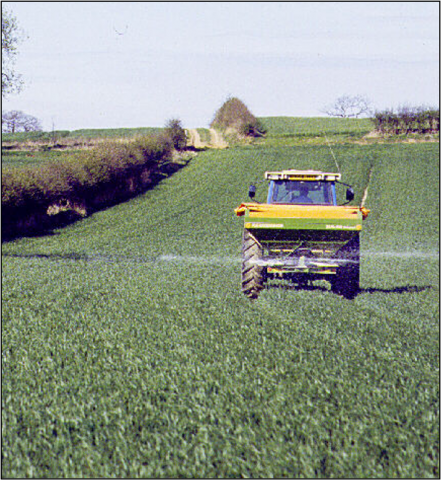Update 13th March 2023: And they’re off! - The 2023 ADAS Nutrition Challenge has begun!

The first fertiliser applications were applied to the 2023 ADAS Nutrition Challenge sites at the end of February, starting the race to be crowned the winner of the best spring fertiliser management strategy!
Nutrition management is a hot topic, with the fluctuations in fertiliser prices and an emphasis on improving nutrient use efficiency driving growers to think more carefully about nutrient products, rates and timings. This challenge aims to test out a range of spring nutrient management approaches to see if we can find new ways to maximise yield while minimising input costs.
Eight companies are challenging the ‘ADAS Experts’ to grow winter wheat crops with the best gross margin at two winter wheat field sites, one on the Yorkshire wolds and the other in Norfolk. There are 16 entries in total, including a ‘nil N’ treatment and an ‘RB209 standard’ as well as the ‘ADAS Experts’ entry.
Entrants have been provided with soil analysis and SMN results from each field, along with crop N content and YEN Nutrition grain nutrient analysis from the previous year’s crops to help fine-tune their approach.
Throughout the season, leaf samples, NDVI imagery and photographs will be taken to monitor crop progress in the standard treatments and entrants will be able to modify their plans depending on those results. Just prior to harvest, biomass samples will be collected from all plots and grain samples will be entered into YEN Nutrition, so we can calculate N use efficiency and N uptake efficiency.
Watch this space for regular updates throughout the season!
Sponsors include: Agro-vital, Aiva Fertiliser, Azotic, Emerald Research, Ilex Envirosciences, Olmix Group, Omya and Timac Agro.
Overview
The format will be similar to the successful winter wheat ‘Fungicide Margin Challenge’ which has been run by ADAS since 2019, in partnership with AHDB for the first three years and independently in 2022. Farmers, agronomists and industry sponsors compete to devise the most cost-effective fungicide programme, with each entry included in replicated small plot trials by ADAS. The target is to achieve the highest margin over fungicide cost and the results have received considerable interest from farmers, agronomists and the media.
In a similar way, entrants in the Nutrition Challenge will compete to devise nutrition programmes which maximise gross margin.
How will it work?
- We hope to fund two small plot trials for harvest 2023, with contrasting soil types and locations.
- All inputs except nutrition will follow standard farm practice and be applied by the host grower.
- Entrants will each design a bespoke spring nutrition programme, to be applied by ADAS; this may include any major and minor nutrients, not just nitrogen, and up to six application timings.
- A range of standard nutrition products will be provided by ADAS for entrants to choose from; any products outside this range will need to be supplied by the entrant.
- Entrants may adjust their programmes during the season in response to crop or weather conditions
- ADAS will include three control input strategies for comparison:
- Untreated (with plots flanked by guards to prevent N robbing from neighbouring treatments)
- Industry Standard
- ADAS Experts’ entry
- For statistical validity, four replicates of each programme will be included, in a randomised block design. Treatment order will be randomly allocated within each block.
- All entrants will receive baseline soil and tissue test results and in-season updates on crop progress.
- Additional tissue sampling during the season, for the refinement of the nutrition programme, is available as an optional extra, but this will be counted as a cost in the calculation of gross margin.
- Biomass and N partitioning will be measured on all treatments, allowing calculation of N use efficiency, N uptake efficiency and N utilisation efficiency.
- Yield and grain nutrient content (YEN Nutrition) will be measured on all plots and statistically analysed.
- All entrants will receive the trial results along with their ranking against all other entrants.
- To encourage innovation without recrimination, strategies and entrants’ names will not be shared without permission
Project funding, and how to enter
Companies working in fertiliser and agronomy are invited to sponsor the trials. To register your interest or for more information, please contact one of:
- Kate Storer, kate.storer@adas.co.uk, 07860 753068
- Susie Roques, susie.roques@adas.co.uk, 07973 719627








